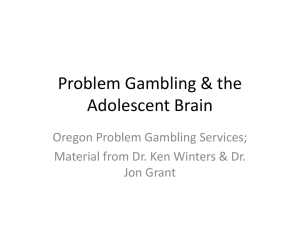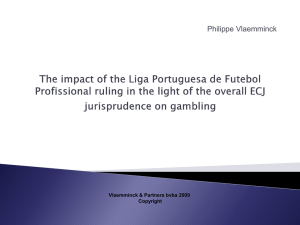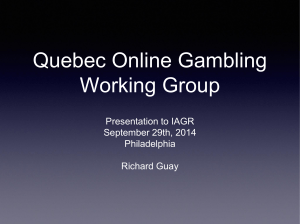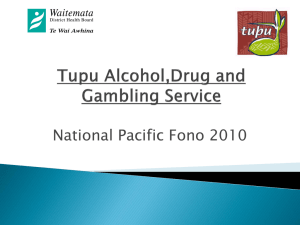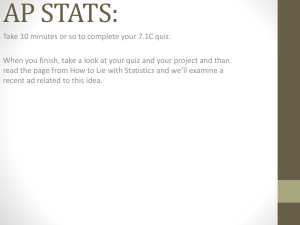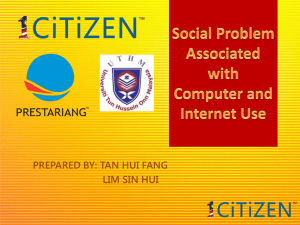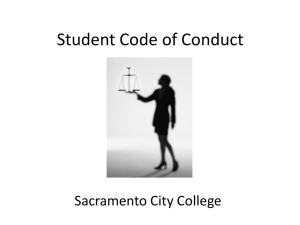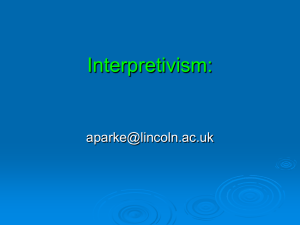Slides
advertisement
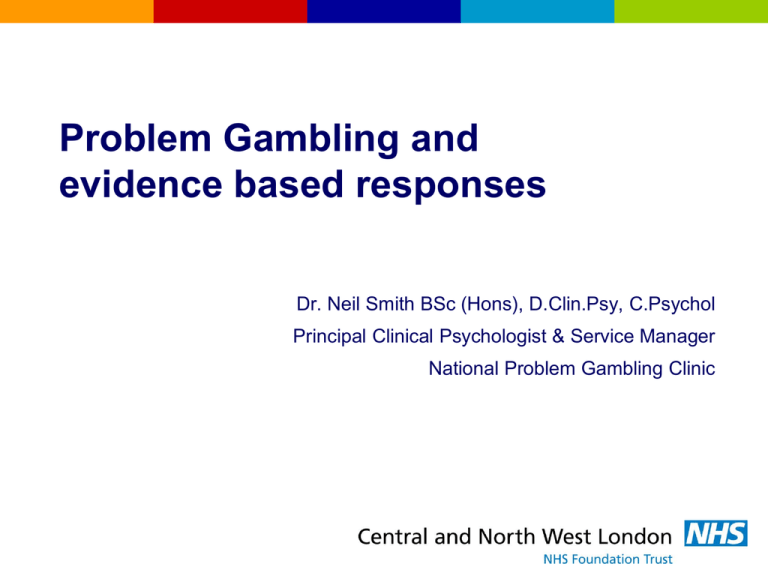
Problem Gambling and evidence based responses Dr. Neil Smith BSc (Hons), D.Clin.Psy, C.Psychol Principal Clinical Psychologist & Service Manager National Problem Gambling Clinic Types of gambling Sports: – Horses, Dogs, football FOBT: – Fixed Odds Betting Terminals, Roulette + Internet: – Online poker, or on-phone Casino: – replacing clubs as late-night drinking option Fruit machines: – can be found on FOBT Socially acceptable gambling – Lottery, Shares Diagnostic terminology: A compulsive and pathological problem disorder Pathological Gambling: – Impulse control disorder as defined by DSM-IV and ICD-10 Compulsive gambling – Original term, used by GA, descriptive term Problem gambling – Broad title to describe problem gambling behaviours – Can be problematic without being pathological Disordered gambling – Possible new DSM-V term Diagnosis DSM-IV Pathological Gambling – 5 or more of: • Preoccupation with gambling activities • Gambling with increasingly larger amounts of money • Repeated unsuccessful attempts to stop or cut down, and being restless or irritable with trying to reduce the behaviour • Gambling to take away these feelings • Gambling to escape from problems or lift mood • ‘Chasing’ losses – returning to try to win back money lost • Lying to family, friends or others about the extent of gambling • Relying on others to provide money to relieve a desperate financial situation caused by gambling • Committing illegal acts to finance gambling • Jeopardising social/occupational opportunities • Making unsuccessful attempts to limit or stop gambling Difference to substance misuse Not much – Substances and alcohol achieve much of their effect using endogenous substances Cerny and Cerny (1992) – Case studies of dependence on carrots – Paper queried what substance in carrots caused dependence Popular misconception – Behaviours and substances act on same systems Assessment and screening Consensus is there is no consensus – Banff consensus (2006) Standardised gambling measures – SOGS, MAGS, GAMTOMS – Problem Gambling Severity Index (PGSI) Brief screening – ‘Lie-Bet’ question • Have you lied about gambling • Have you ever felt the need to bet more and more money – Brief Biosocial gambling screen (BBGS; Gebauer et al, 2010) • Validated against DSM-IV criteria (5+) Prevalence: Gambling British Gambling Prevalence Survey 2010 73% of population gambled last year (56% less lottery) – Up from 68% and 48% respectively in 2007 – Sport in bookmakers 3-9%; online 3-5%; FOBT 3-4% Gambling highest amongst: – Male, white-British, married, with qualifications, working in ‘lower-supervisory technical’ areas, with higher income Prevalence: Problem gambling British Gambling Prevalence Survey 2010 Using DSM-IV criteria 0.9% of population (CI: 0.7-1.2%) – Up from 0.6% 2007 (p=.049) – PGSI suggest no significant increase 0.5% - 0.7% Estimated 342,000 – 593,000 16+ Odds of being a problem gambler increased from 2007-2010 by 1.5 times 64 problem gamblers out of 7756 respondents – Prevalence of PG highest amongst pub/club poker players, online and FOBT 50.0 Treatment seeking population: ‘What is problematic?’ 47.0 45.0 40.0 37.1 28.8 30.0 25.0 20.0 13.6 Private Skill 0.8 0.8 1.5 Gen.Spread Fin.Spread Gaming machines Sport 2.3 2.3 Dogs Bingo Bookmakers 2.3 FOBT 3.0 Casino table TV Mobile Internet 0.0 0.8 Telephone 5.0 3.1 6.8 6.9 6.8 Sp.Spread 6.8 Casino machine 10.0 10.7 9.1 Horses 15.0 Lottery Percentage 35.0 Associated problems Debt Depression Suicidality Relationship breakdown Social isolation Pressure on families and carers Loss of employment Crime Health – Morasco et al, 2006 Co-occurring MH difficulties Substance use in PG 25-63% (Crockford & el-Guebaly, 1998) PG in substance misuse 9-30% (Lesieur et al, 1986) – Rate of PG increases with no. of substances used 76% meet criteria for Major Depression (McCormick et al, 1984) – PG precedes depression in 86% of cases 20% of 162 GA members attempted suicide (Moran, 1969) – 76% had thought about it 93% of treatment seekers meet criteria for PD (Blaszczynski & Steel, 1998) ASPD possibly most likely, although link obscured by presence of poly-substance PG more likely to meet criteria for ADHD (Specker et al, 1995) Types of gambler Pathways Model (Blaszczynski and Nower, 2002) 1. Behaviourally conditioned – May be chance entry, no significant co-morbidity – Low end of PG continuum, prey to conditioning effects 2. Emotionally vulnerable – Negative family backgrounds, life events, developmental – Low self-esteem and emotional escape though gambling 3. Anti-social/Impulsive – Wider range of behavioural problems, negative emotions interpersonal difficulties, poly-drug, criminality Evidence based treatment Psychological – CBT – MI / Brief – Innovations Pharmacological – Opioid – Anti-depressants – Dopaminergic Psychological: Meta Analyses, Palleson et al, 2005: ‘Outcome of psychological treatments’ 22 studies selected, 1434 subjects – 11 studies CBT – ‘Eclectic’, 12 step, exposure, MI, relaxation Overall effect size for psychological treatment 2.01; at follow-up 1.59 No differentiation between treatments Lower effect size with formal PG diagnosis Relationship between session N and outcome Psychological: Meta-Analyses Gooding and Tarrier 2009 Systematic review and meta-analysis of cognitivebehavioural interventions (Gooding and Tarrier, 2009) 25 studies overall - immediate & follow-up – 1078 had pre and immediate post scores Effect sizes (ES) for range of outcomes – Abstinence, ‘bout duration’, frequency, SOGS 0-3 month ES overall 0.72; 6month 0.56 – 0-3mnth Abstinence 1.87; more effective with males – No difference in mode of delivery Psychological: Meta-Analyses, Gooding and Tarrier 2009 ‘robust short term effects which do endure’ Significant in spite of study variability ‘Desire to gamble’, not frequency significant at 6 months Only group CBT significant at 6 months, but a trend for greater effectiveness of individual when compared directly with group No effect of session number or length CBT models Robert Ladouceur – Earlier RCTs in Canada, strong cognitive correction element – 2001 RCT- up to 20 sessions (avg.11); 2007 self-help workbook Nancy Petry – Cognitive-behavioural programme, 8 session manualised – Contingency management element, 2006 RCT Tian Oei – Cognitive-behavioural programme with therapist manual 2010 – RCT 6 x 2hourly sessions; Manual = 10 session with electives, Models comparison Ladouceur Petry Oei Relapse prevention X X X Stimulus control X X X Motivational work X X Alternative activities X Reinforcement X Extended cognition work X X X Debt X X Assertiveness X X Family issues X Imaginal exposure X Motivational treatments RCTs show Motivational Interviewing or Motivational Enhancement Therapy superior to self-help interventions or wait-list controls Hodgins et al 2001 and 2009 – MI interventions greater improvements compared with wait-list control Petry et al 2008 – 1 session MI > 4 session MI+CBT Brief interventions Petry et al 2008 – 10 minute check-up > 1 session > 4session MI/CBT – Non-treatment seeking sample Hodgins et al, 2001 – 30 min telephone MI session + workbook > work book only Hodgins et al 2009 – ‘More is not necessarily better’ – 30 min telephone MI session + workbook vs. addition of booster phone calls – Both interventions better than wait-list control – No differences between two active interventions Innovations in psychological treatment Remote working – Internet and phone support, (Carlbring and Smit, 2008) ‘Third wave’ – ACT: Mark Dixon, Southern Illinois University research – Mindfulness and problem gambling (Lisle et al, 2011) – Metacognitions: controlling gambling thoughts predict gambling behaviour (Lindberg et al, 2010) – Imagery: early big win memories and the effect on gambling Implicit learning – Cue exposure/inhibition work in alcohol (e.g. Houben et al, 2011) – Cognitive-bias modification? Promising results in depression Pharmacological treatment Research indicates involvement of – Serotonergic, noradrenergic, dopaminergic and opioidergic systems in pathological gambling Good results for mood stabilisers, anti-depressants and opioid antagnoists (Palleson et al, 2007) – Overall effect size 0.78 – No difference between 3 main classes of pharmacological intervention Bupropion vs pretreatment 1.71 Black, 2004 Fluvoxamine vs placebo 0.56 Blanco et al, 2002 Topirte vs pretreatment 0.69 Dannon et al, 2005 Fluvoxamine vs pretreatment 0.27 Topirate vs fluvoxamine* 0.45 Bupropion vs pretreatment 0.82 Naltrexone vs pretreatment 0.63 Bupropion vs naltrexone* 0.08 Paroxetine vs placebo 0.05 Grant et al, 2003 Nalmefene (25 mg) vs placebo 0.57 Grant et al, 2006 Nalmefene (50 mg) vs placebo 0.6 Nalmefene (100 mg) vs placebo 0.28 Escitalopram vs pretreatment 1.2 Grant and Potenza, 2006 Fluvoxamine vs placebo 0.48 Hollander et al, 2000 Lithium carbonate vs placebo 0.58 Hollander et al, 2005 Naltrexone vs pretreatment 1.79 Kim & Grant, 2001 Naltrexone vs placebo 1.55 Kim et al, 2001 Paroxetine vs placebo 1.24 Kim et al, 2002 Nefazodone vs pretreatment 1.07 Pallanti et al, 2002 Lithium carbonate vs pretreatment 1.8 Pallanti et al, 2002 Valproate vs pretreatment 1.88 Valproate vs lithium carbonate* 0.2 Sertraline vs placebo 0.11 Sa´iz-Ruiz et al, 2005 Citalopram vs pretreatment 2.48 Zimmerman et al, 2002 Dannon et al, 2005 Opioid antagonists Use is based on theory that over-production of opioids contributes to PG ++B-endorphins = disinhibition of dopamine neurons in ventral tegmentum and nucleus accumbens Naltrexone blocks endorphins = reduced NA dopamine RCTs find that opioid antagonists superior to placebo in reducing gambling severity (Kim et al, 2001; Grant et al, 2006; Grant et al 2008) Anti-depressants Mixed results with antidepressant trials to reduce problem gambling SSRIs most frequently examined Strong results when compared to pretreatment RCTs show high placebo response rates – Fluvoxamine, Sertraline, Paroxetine, Escitalopram, Buproprion have shown no difference to placebo – Paroxetine > placebo (Kim et al, 2002) Dopamine treatment? Agonists known to increase problem gambling (Smith, Kitchenham and Bowden-Jones, 2011) So antagonist will reduce? – Haloperidol increased motivation to gamble and psychophysiological measures of arousal (Zack and Poulus, 2007) Unclear picture – Low level antagonists may increase dopamine (Frank & O’Reilly, 2006) May be role for D2 Agonist – Has role in blocking sensitivity to cost of reward (Dagher, 2012) ‘Monash’ Guidelines Extensive review of literature pertaining to screening assessment and treatment of PG; published in conjunction with Monash University/ University of Melbourne with support of State of Victoria Gave strength of evidence rating A-D ‘Individual or group CBT’; Motivational Interviewing and Motivational Enhancement Therapy’ given ‘B’ rating (body of evidence can be trusted to guide practice in most situations) Practitioner delivered over self-help interventions (‘B’) Naltrexone (‘C’ – ‘some support’); Not to use antidepressants to reduce gambling (‘B’) Further reading: Pathological gambling: etiology, comorbidity and treatment. Nancy Petry, 2005 A cognitive-behavioural therapy programme for problem gambling: Therapist manual. Raylu and Oei, 2010 Overcoming Your Pathological Gambling. Robert Ladouceur & Stella Lachance. 2007 Overcoming Compulsive Gambling. Alex Blacszczynski, 1998
